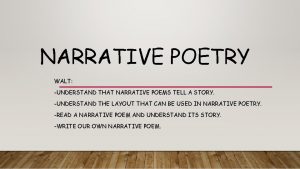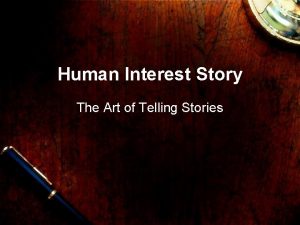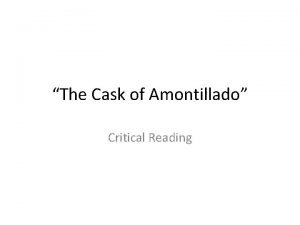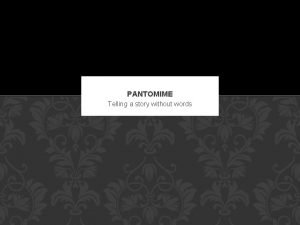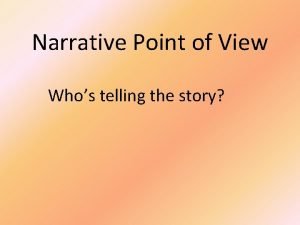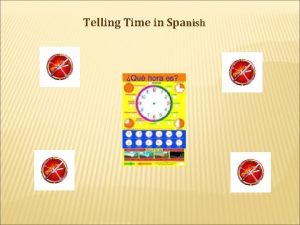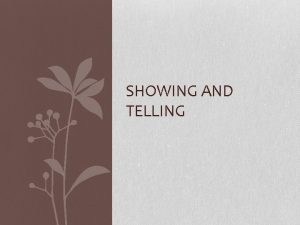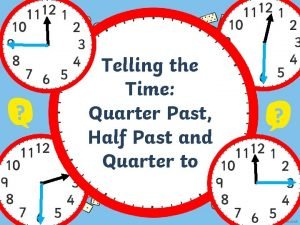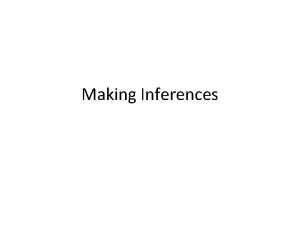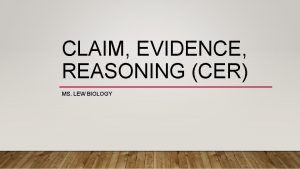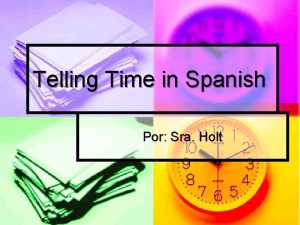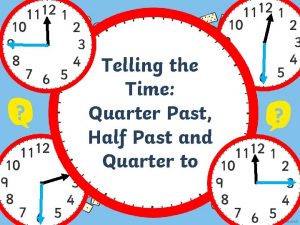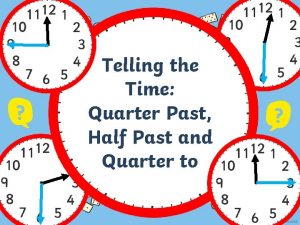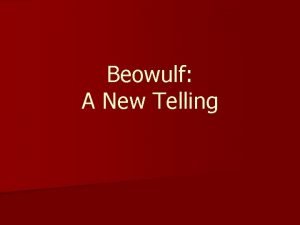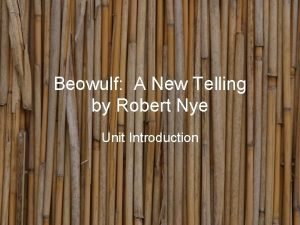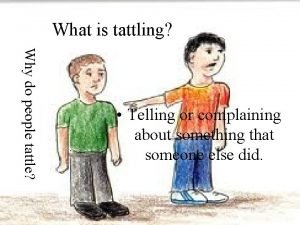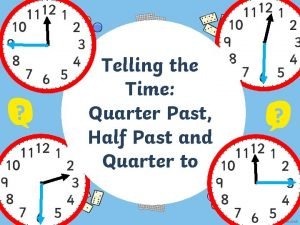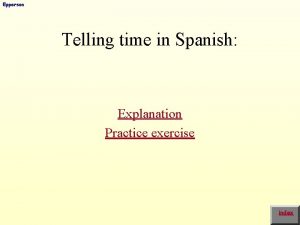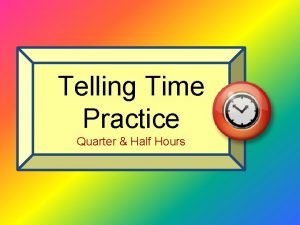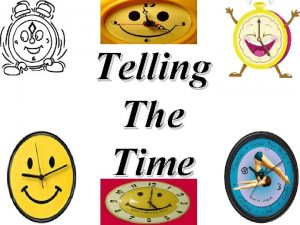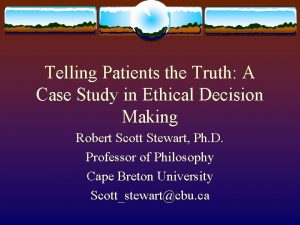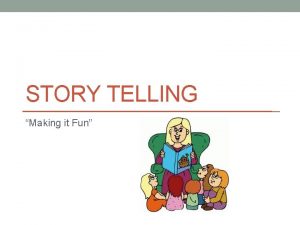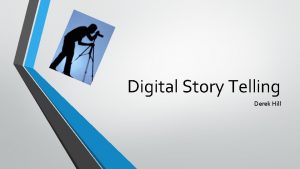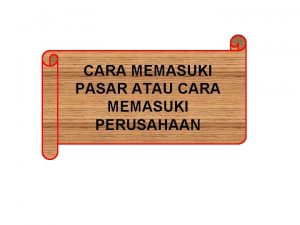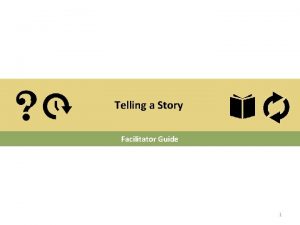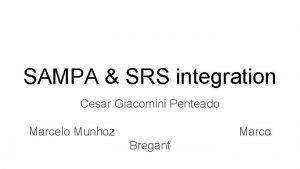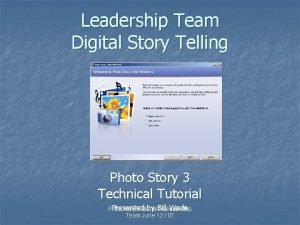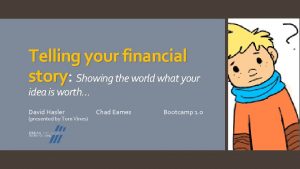Telling a Strategic Story with Data Cara Giacomini



































- Slides: 35

Telling a Strategic Story with Data Cara Giacomini, Ph. D, Director of Advancement Analytics June 2019| UW Web Council 1

introduction why am I here today? What is this presentation about? o How to effectively use data to tell your story o Based on workshops I’ve co-taught nationally Why am I here? o (Short answer) Thom saw a version of this presentation at Tech. Connect and thought you’d find it useful o (Better answer) Because measuring the right things and telling our story well can help us reach our biggest, most audacious goals 2

presentation outline three sections 1 2 3 start with why align data and strategy consider the elements of a good story 3

“People don’t buy what you do, they buy why you do it. ” “We’d achieve more if we chased our dreams instead of our competition. ” 4

start with why what “Every organization on the planet knows WHAT they do. WHAT These are the products they sell and the services they offer. ” 5

start with why example - what University of Washington ANNUAL PHILANTHROPY ● All gifts to UW under $25 K University Advancement Annual Philanthropy ● Solicitation letters, emails, and phone calls ● Husky Giving Day (April 4) ● Leadership-level fundraising ($2, 000 -$25, 000 a year) ● Student philanthropy 6

start with why how “Some organizations know HOW they do it. HOW WHAT These are they things that make them special or set them apart from the competition” 7

start with why example - how ANNUAL PHILANTHROPY University of Washington University Advancement Annual Philanthropy ● ● ● ● Integrated analytics Predictive models Marketing automation Segmentation Engagement scores Personalization Centralization 8

start with why “Very few organizations know WHY they do what they do. WHY HOW WHAT Why is not about making money. That’s a result. It is a purpose, cause or belief. It’s the very reason your organization exists. ” 9

start with why example - why University of Washington ANNUAL PHILANTHROPY University Advancement Annual Philanthropy To inspire a lifetime of giving 10

start with why example - why University of Washington ENTERPRISE SERVICE CENTER UW Information Technology Enterprise Service Center To keep the UW community working 11

start with why WHY Change direction - start with WHY HOW WHAT 12

presentation outline three sections 1 2 3 start with why align data and strategy consider the elements of a good story 13

Start Smart with Data: 10 Steps for Success “If you do not have a clear direction for which to aim, there is nothing to measure. ” - Cara Giacomini https: //er. educause. edu/blogs/2018/12/start-smart-with-data-10 -steps-for-success 14

start smart align data with strategy Understand the strategy ➢ What is the short- and long-term strategy for your unit, service, or area of work? ➢ What are the primary business goals (not technology goals? ) 15

start smart example - strategy University of Washington University Advancement Annual Philanthropy ANNUAL PHILANTHROPY To inspire a lifetime of giving Strategy - We focus on renewing as many donors as possible over multiple years, as well as expanding our pipeline by adding and reactivating donors 16

start smart align data with strategy Define what success looks like ➢ How will you know if your strategy is successful? ➢ What would failure look like? ➢ What small steps indicate movement in the right direction? 17

start smart example - define success 18

start smart align data with strategy Reality check Introducing metrics that don’t tell a meaningful story can inadvertently motivate people to ignore data 19

start smart example - using the wrong metric 20

start smart align data with strategy Identify your audience ➢ Who will review and receive the data? ➢ What actions are they empowered to take based on the results? ➢ Do they agree with the strategy? 21

start smart align data with strategy Reality check If you do not have an audience empowered (and willing) to act on the data you generate, you need to spend more time building supportive relationships before you introduce metrics. No amount of data will convert an active skeptic. Every data story needs a champion. 22

presentation outline three sections 1 2 3 start with why align data and strategy consider the elements of a good story 23

pitfall not telling a cohesive story Service Health Score 87. 2 24

pitfall what went wrong ● ● ● Numbers without context Not connecting data to a strategic goal or business need All numbers, no people Inconsistent metric definitions and measurement periods No clear action Audience left feeling “So What? ” 25

Elements of a Good Story CONFLICT CHARACTER SETTING PLOT THEME What are you solving? Who is this story about? What will set the scene? What is going on? What did we learn? AUDIENCE Who is listening to our story? What do they need to know? 26

conflict what are we solving? What is our strategic goal or business need? o Boost reputation of UW o Encourage behavior—student admissions, advocacy, event attendance, donations Possible Metrics o Views of (specific) Web pages o Interactions with social media posts o Sentiment analysis of posts/comments o Online event registration counts o Donations via online platform 27

character who is this story about? Who benefits from UW web sites/digital media? o Faculty, Staff, Students o Seattle community, UW units, organizations o Specific populations tied to strategic goals Possible Metrics o Who visits/engages (when identity is known)? o What characteristics do we know (when identity is unknown)—region, other sites visited, level of engagement? o Personas—what distinct groups can we identify? 28

setting what will set the scene? What context do we need to understand the data? o Definitions of metrics (level setting—everyone speaking same language) o Baselines and trends (What is high? What is low? ) o What would success look like? Possible Metrics o How many views do we have per day, week, year? o How many/what level of increase in views, registrations, shares, comments, etc. indicate we are moving in the direction we desire? o How does this persona/segment typically interact with our content? 29

plot what is happening? How is the story unfolding now? o Latest numbers o Timely information o Significant recent changes Possible Metrics o Daily or weekly counts o Recent activity o Comparisons to same time period last week/year o Comparisons to similar content Note—when there is no strategy, this is where people tend to focus 30

theme what did we learn? What should we do with this information? o Find actionable insights o Tailor future content, identify new audiences, cultivate channels o Assess effectiveness of our strategy o Know if we met our goals Possible Metrics o Key Performance Indicators—identified metrics most aligned with success and monitor them going forward o Create thresholds that automatically trigger notifications/events/actions 31

audience who is listening to our story? Who will receive the data? o What part of our story is most important to our audience? o How familiar is our audience with our strategy, success criteria, and data? o How will our audience use the data? Communicating Metrics o Focus on main takeaway o Less is more; be concise; simplify visuals o Use non-technical language o Aim to spark discussion and action – audience should walk away with ideas of how to respond to data shared 32

Elements of a Good Story CONFLICT CHARACTER SETTING PLOT THEME What are you solving? Who is this story about? What will set the scene? What is going on? What did we learn? AUDIENCE Who is listening to our story? What do they need to know? 33

presentation outline three sections 1 2 3 start with why align data and strategy consider the elements of a good story 34

QUESTIONS? cgiacomi@uw. edu 35
 Giacomini veni
Giacomini veni Moodle agraria unipd
Moodle agraria unipd A poem that tells a story.
A poem that tells a story. Human interest article example
Human interest article example Hyperbole in the cask of amontillado
Hyperbole in the cask of amontillado Short story grade 7
Short story grade 7 Music that tells a story without words
Music that tells a story without words Whos telling the story
Whos telling the story Strategic fit vs strategic intent
Strategic fit vs strategic intent Complements and substitutes
Complements and substitutes Strategic management and strategic competitiveness
Strategic management and strategic competitiveness Strategy analysis and choice largely involves making
Strategy analysis and choice largely involves making Practice telling time in spanish
Practice telling time in spanish Telling sentences
Telling sentences Telling details
Telling details Telling sentence
Telling sentence Change j cole
Change j cole Why is charlie telling hashim jokes?
Why is charlie telling hashim jokes? Telling time and date
Telling time and date Time quarter past
Time quarter past What was miss valdez telling larry
What was miss valdez telling larry Queenie slip or trip
Queenie slip or trip Telling time in spanish chart
Telling time in spanish chart Quarter half past
Quarter half past Time in quarter
Time in quarter Telling time in hawaiian
Telling time in hawaiian The setting of beowulf
The setting of beowulf Beowulf a new telling
Beowulf a new telling What is tattle telling
What is tattle telling What time is quarter to 4
What time is quarter to 4 Time telling exercise
Time telling exercise Telling selling participating delegating
Telling selling participating delegating Onyourclock
Onyourclock Telling time notes
Telling time notes Whats a quarter past 7
Whats a quarter past 7 Who's telling the truth case study
Who's telling the truth case study


